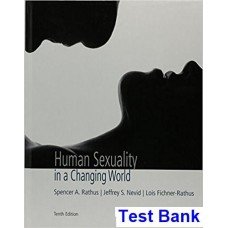Human Sexuality Diversity in Contemporary Society 10th Edition By William Yarber – Test Bank
Human Sexuality, 10e (Yarber)
Chapter 14 Sexual Function Difficulties, Dissatisfaction, Enhancement, and Therapy
1) According to a study by McCarthy and McCarthy (2003, 2009), less than ________ of happy, sexually satisfied couples described having similar desire, arousal, orgasm, and pleasure during a particular sexual episode.
- A) 15 percent
- B) 25 percent
- C) 50 percent
- D) 75 percent
Answer: C
Explanation: Sexual Function Difficulties: Definitions, Types, and Prevalence
Difficulty: 1 Easy
Topic: Sexual Function Difficulties
Learning Objective: Define sexual function difficulties, explain factors that affect prevalence, and list the four subtypes.
Bloom’s: Remember
APA Outcome: 1.2: Develop a working knowledge of psychology’s content domains
Accessibility: Keyboard Navigation
2) According to a study by McCarthy and McCarthy (2003, 2009), for about ________ of the sexual experiences, one partner described the sex as positive, whereas the other considered it “OK.”
- A) 15 percent
- B) 25 percent
- C) 50 percent
- D) 75 percent
Answer: B
Explanation: Sexual Function Difficulties: Definitions, Types, and Prevalence
Difficulty: 1 Easy
Topic: Sexual Function Difficulties
Learning Objective: Define sexual function difficulties, explain factors that affect prevalence, and list the four subtypes.
Bloom’s: Remember
APA Outcome: 1.2: Develop a working knowledge of psychology’s content domains
Accessibility: Keyboard Navigation
3) According to a study by McCarthy and McCarthy (2003, 2009), ________ of sexual experiences were considered unremarkable, even though there were no sexual function problems. If the couple had to do it over again, they probably would have chosen something else to do.
- A) 15 percent
- B) 25 percent
- C) 50 percent
- D) 75 percent
Answer: A
Explanation: Sexual Function Difficulties: Definitions, Types, and Prevalence
Difficulty: 1 Easy
Topic: Sexual Function Difficulties
Learning Objective: Define sexual function difficulties, explain factors that affect prevalence, and list the four subtypes.
Bloom’s: Remember
APA Outcome: 1.2: Develop a working knowledge of psychology’s content domains
Accessibility: Keyboard Navigation
4) The DSM-5 defines sexual dysfunction as ________.
- A) a pathological inability to regulate arousal states, to delay or achieve ejaculation, and/or to control orgasms
- B) a clinically significant disturbance in a person’s ability to respond sexually or to experience sexual pleasure
- C) a condition characterized by a lack of interest in sexual activities caused by depression
- D) a diminution of sexual functioning in one of the four phases of sexual response
Answer: B
Explanation: Sexual Function Difficulties: Definitions, Types, and Prevalence
Difficulty: 1 Easy
Topic: DSM-5
Learning Objective: Define sexual function difficulties, explain factors that affect prevalence, and list the four subtypes.
Bloom’s: Remember
APA Outcome: 1.1: Describe key concepts, principles, and overarching themes in psychology
Accessibility: Keyboard Navigation
5) Which of the following is true of sexual function dissatisfaction?
- A) It reflects a societal perception and has broad medical focus.
- B) It is a common outcome of a difficulty in sexual functioning.
- C) It begins with a man-centered definition of sexual function problems.
- D) It acknowledges an overarching definition of what is “normal” versus what is dysfunctional.
Answer: B
Explanation: Sexual Function Difficulties: Definitions, Types, and Prevalence
Difficulty: 2 Medium
Topic: Sexual Function Difficulties
Learning Objective: Define sexual function difficulties, explain factors that affect prevalence, and list the four subtypes.
Bloom’s: Understand
APA Outcome: 1.2: Develop a working knowledge of psychology’s content domains
Accessibility: Keyboard Navigation
6) The term “sexual function dissatisfaction” is a useful term because ________.
- A) dissatisfaction is very different from dysfunction
- B) it acknowledges sexual scripts as individual and avoids a definition of “normal”
- C) it is a standard medical diagnosis identified in the DSM-5
- D) dissatisfaction is more understandable than dysfunction to the general public
Answer: B
Explanation: Sexual Function Difficulties: Definitions, Types, and Prevalence
Difficulty: 2 Medium
Topic: Sexual Function Difficulties
Learning Objective: Define sexual function difficulties, explain factors that affect prevalence, and list the four subtypes.
Bloom’s: Understand
APA Outcome: 1.2: Develop a working knowledge of psychology’s content domains
Accessibility: Keyboard Navigation
7) According to the DSM-5, which of the following is a sexual dysfunction?
- A) Peyronie’s disease
- B) priapism
- C) ejaculatory inevitability
- D) premature ejaculation
Answer: D
Explanation: Sexual Function Difficulties: Definitions, Types, and Prevalence
Difficulty: 2 Medium
Topic: Premature (Early) Ejaculation; DSM-5
Learning Objective: Define sexual function difficulties, explain factors that affect prevalence, and list the four subtypes.
Bloom’s: Understand
APA Outcome: 1.2: Develop a working knowledge of psychology’s content domains
Accessibility: Keyboard Navigation
8) According to the Working Group for a New View of Women’s Sexual Problems, the DSM-5 has shortcomings as applied to women. Which of these is one of those shortcomings?
- A) an overemphasis on the physical differences between men and women
- B) the use of clinical impressions, as opposed to actual data
- C) the unacknowledged role of relationships in sexuality
- D) a bias toward labeling women’s experiences as abnormal
Answer: C
Explanation: Sexual Function Difficulties: Definitions, Types, and Prevalence
Difficulty: 1 Easy
Topic: Sexual Function Difficulties; Premature (Early) Ejaculation
Learning Objective: Define sexual function difficulties, explain factors that affect prevalence, and list the four subtypes.
Bloom’s: Remember
APA Outcome: 1.2: Develop a working knowledge of psychology’s content domains
Accessibility: Keyboard Navigation
9) A New View of Women’s Sexual Problems is a unique approach to looking at sexual problems because it
- A) labels sexual function difficulties as disorders and characterizes them according to Masters and Johnson’s sexual response cycle
- B) focuses on lesbian health issue relationships
- C) classifies women’s sexual function difficulties based on women’s needs and sexual realities
- D) translates the DSM-5 categories into laypeople’s language
Answer: C
Explanation: Sexual Function Difficulties: Definitions, Types, and Prevalence
Difficulty: 2 Medium
Topic: Sexual Function Difficulties
Learning Objective: Define sexual function difficulties, explain factors that affect prevalence, and list the four subtypes.
Bloom’s: Understand
APA Outcome: 1.2: Develop a working knowledge of psychology’s content domains
Accessibility: Keyboard Navigation
10) The National Survey of Sexual Health and Behavior (NSSHB) found that ________.
- A) younger men experience erectile dysfunction more often than older men
- B) men with a relationship partner experience greater arousal than those with a nonrelationship partner
- C) men reporting same-sex activity have greater levels of sexual desire
- D) older men are more likely to experience orgasm
Answer: B
Explanation: Sexual Function Difficulties: Definitions, Types, and Prevalence
Difficulty: 2 Medium
Topic: National Survey of Sexual Health and Behavior
Learning Objective: Define sexual function difficulties, explain factors that affect prevalence, and list the four subtypes.
Bloom’s: Understand
APA Outcome: 1.2: Develop a working knowledge of psychology’s content domains
Accessibility: Keyboard Navigation
11) Which of the following is true according to the National Health and Social Life Survey (NHSLS)?
- A) Sexual dysfunctions are influenced by both health-related and psychosocial factors.
- B) Sexual dysfunctions are more prevalent among men than women.
- C) Sexual dysfunctions are associated with high quality of life and extravagant lifestyles.
- D) Sexual dysfunctions are generally most common among very old women and young men.
Answer: A
Explanation: Sexual Function Difficulties: Definitions, Types, and Prevalence
Difficulty: 2 Medium
Topic: National Health and Social Life Survey
Learning Objective: Define sexual function difficulties, explain factors that affect prevalence, and list the four subtypes.
Bloom’s: Understand
APA Outcome: 1.2: Develop a working knowledge of psychology’s content domains
Accessibility: Keyboard Navigation
12) The number-one sexual function problem of American couples is ________.
- A) inhibited sexual desire
- B) hypersexual disorder
- C) substance-induced sexual dysfunction
- D) orgasmic disorder
Answer: A
Explanation: Sexual Function Difficulties: Definitions, Types, and Prevalence
Difficulty: 1 Easy
Topic: Disorders of Sexual Desire
Learning Objective: Define sexual function difficulties, explain factors that affect prevalence, and list the four subtypes.
Bloom’s: Remember
APA Outcome: 1.2: Develop a working knowledge of psychology’s content domains
Accessibility: Keyboard Navigation











Reviews
There are no reviews yet.